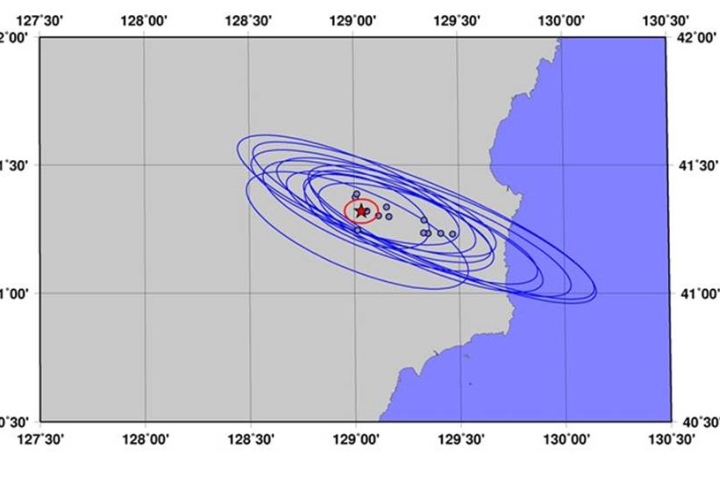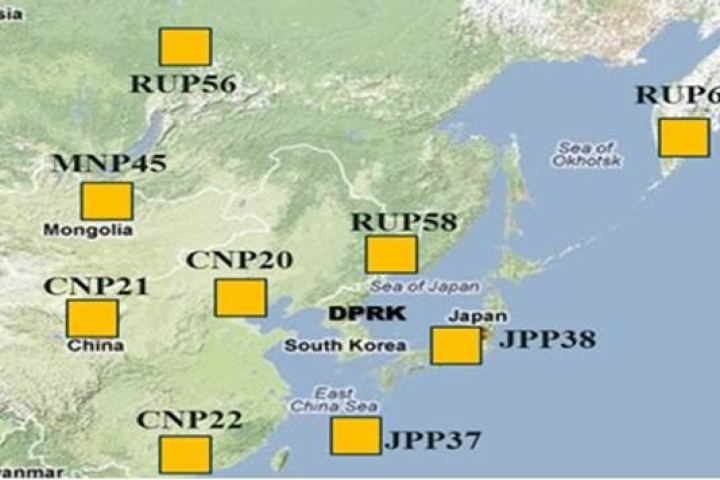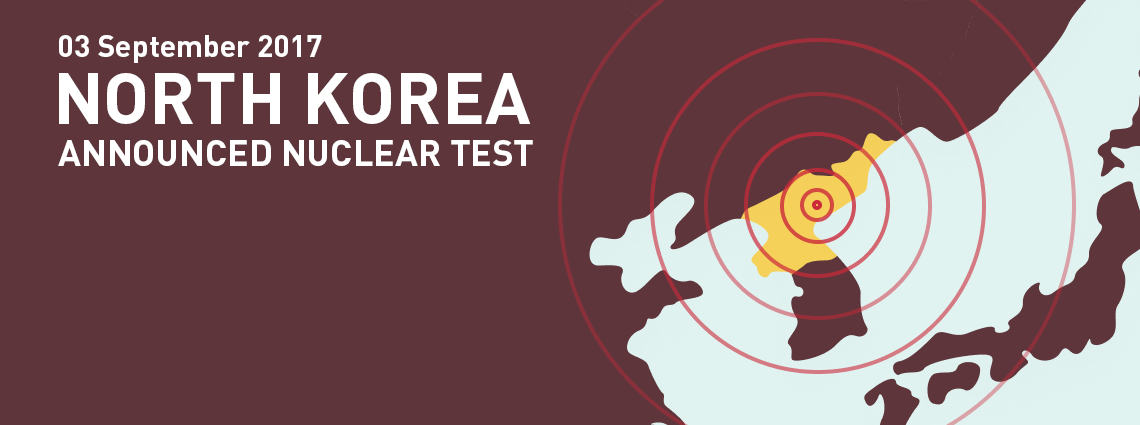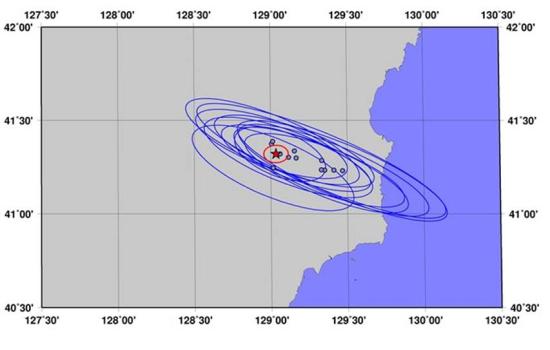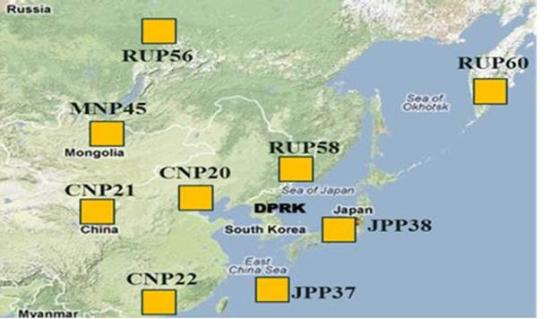September 2017 DPRK Nuclear Test
An Unusual Seismic Event
CTBTO's monitoring stations picked up an unusual seismic event in the Democratic People’s Republic of Korea (DPRK) on 3 September 2017 at 03:30 (UTC). Over 100 of our stations contributed to the analysis. The characterization of the event is consistent with a man-made explosion. An initial magnitude estimate of 5.8 has now been revised to 6.1. The event was significantly larger than earlier ones recorded by the system and the location estimate shows that the event took place in the area of the DPRK’s nuclear test site.
This explosion can only be classified as nuclear once corresponding airborne radioactivity is detected. Should traces of radioactivity have been released from the event, typically in the form of the radioactive noble gas xenon, they would need to be transported through the atmosphere to one of the radionuclide stations in the region, detected, sampled and analyzed. Results, if any, can be expected within days or weeks.
For breaking news please follow us on Twitter @ctbto.
Remarks, Statements and Report
3 Sept. 2017
Statement by the Chairperson of the CTBTO PrepCom
[Download PDF]
4 Sept. 2017
CTBTO Executive Secretary Zerbo's remarks at the resumed 48th PrepCom session
[Download PDF]
Under-Secretary-General Feltman's remarks to the Security Council on the nuclear test announced by the DPRK
[Download PDF]
Technical findings
7 September 2017
The initial automatic detection of the event was made on 3 September 2017 at 03:30 UTC with 36 seismic stations contributing. The initial estimate of the event's magnitude was 5.8, which was revised to 6.1 in the course of further analysis. The location estimate shows that the event took place in the area of the DPRK’s nuclear test site. The data was made available to Member States immediately, as were the results of the first automatic analysis that followed around one hour later. More refined automatic processing was made available within four and six hours of the event.
Result of seismic analysis: a man-made explosion
In the course of 5 September, the Revised Event Bulletin (REB) was issued, which is the result of human analysis. The characterization of the event is consistent with a man-made explosion. This explosion can only be classified as nuclear once corresponding airborne radioactivity is detected.
The error ellipse (red) has shrunken to +/- 6.7 km or 109 km2, well within Treaty requirements for an on-site inspection. In the process, the Reviewed Event Bulletin used data from additional seismic stations including auxiliary seismic stations. This includes detections at 41 primary and 90 auxiliary seismic stations. Signals were also associated at two hydroacoustic stations and one infrasound station. The International Monitoring System (IMS) consists of 50 primary and 120 auxiliary seismic stations, of which 42 and 107 respectively are certified.
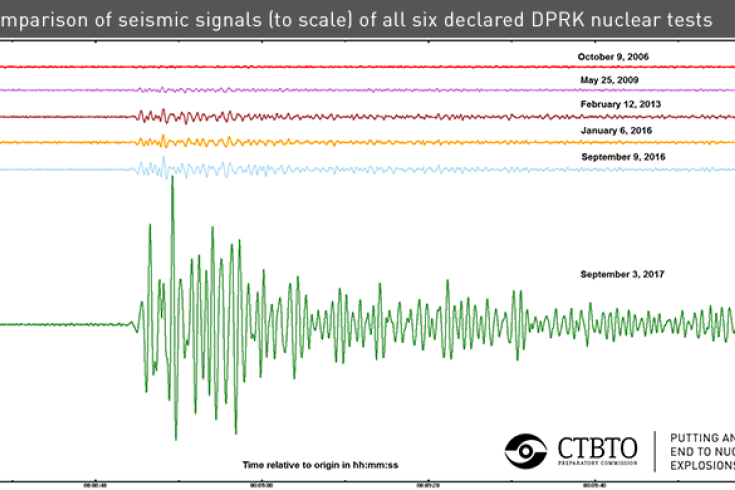
Second event
IDC automatic processing detected a second event that occurred 8.5 minutes later at 3:38 UTC.. Analysis using cross-correlation places the second event at approximately the same location as the main event, but 2.0 units of magnitude smaller. This event is not an explosion.
Potential for Radionuclide Detections
Should traces of radioactivity have been released from the event, typically in the form of the radioactive noble gas xenon, they would need to be transported through the atmosphere to one of the radionuclide stations in the region, detected, sampled and analyzed. Results, if any, can be expected within days or weeks. After the 2013 announced nuclear test, xenon was detected around 55 days after the event. Under the Comprehensive Nuclear-Test-Ban Treaty (CTBT), the determination of an event's nature - nuclear explosion or not - lies with the Member States and their National Data Centres. The atmospheric transport simulation below is based on the hypothesis that a release of radionuclides occurred immediately and continuously from the location of the seismic detection.
Under the Comprehensive Nuclear-Test-Ban Treaty (CTBT), the determination of an event's nature - nuclear explosion or not - lies with the Member States and their National Data Centres.
The atmospheric transport simulation below is based on the hypothesis that a release of radionuclides occurred immediately and continuously from the location of the seismic detection.
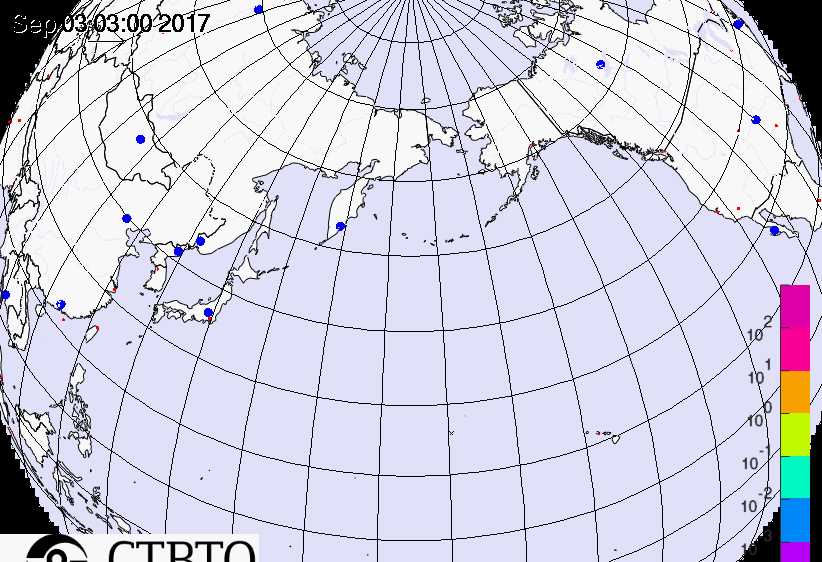
Update 27 April 2018
Since 3 September 2017, the IMS network has detected more than 30 smaller aftershocks in the vicinity of the test site. Mounting evidence suggests that the second signal recorded on 3 September, roughly eight minutes after the initial blast, is indeed consistent with a cavity collapse.
Atmospheric transport simulations at the time of the announced test and collapse event shows the hypothetical release and plume dispersal. There was no radioactivity detected from the test or any aftershocks.
Due to the significant time delay, there is now very little chance of detectable radioactivity being transported to IMS stations in the region (see map) even if the test site degrades.
